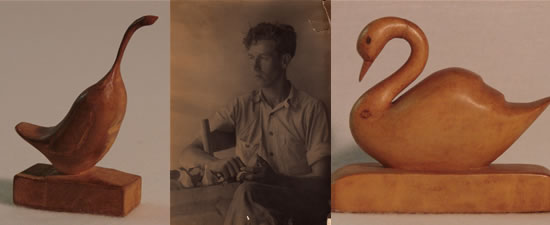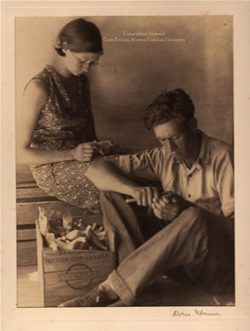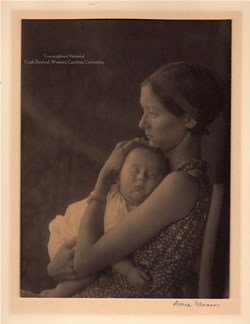The People:
Bonnie and Hayden Hensley
Bonnie H. Logan Hensley (1913-2001) and James Hayden Hensley (1911-2001) were among the first residential students to attend the John C. Campbell Folk School during the winter of 1927-1928. They married in the early 1930s. They carved—independently and collaboratively—into the 1940s. Doris Ulmann photographed Hayden Hensley in the summer of 1933. John Jacob Niles, accompanying Ulmann on that trip, wrote, “Mr. Hensley is perhaps the most outstanding wood-carver in all the Brasstown country. He is supporting himself, his wife and his two children entirely by his crafts.” Indeed, the Hensleys made their full time living from carving and boasted of a beautiful little house “that carving built.” 1
Born in 1911 to Oscar and Mary Donaldson Hensley, Hayden Hensley was raised in Cherokee County. In addition to farming, his father worked at a sawmill and at various public work jobs. His maternal grandparents were Will Donaldson and Kate C. Donaldson, a maker known for creating a unique type of appliquéd blanket, known as an “Italian Cow Blanket.” Published accounts of these blankets usually list her as “Granny Donaldson.” In a 1989 interview, Hayden Hensley credited his grandmother Donaldson with convincing him to attend the John C. Campbell Folk School where he enrolled in the school’s first session in the winter of 1927. That first winter that Hayden Hensley was at the school, he slept in the Log Cabin Museum along with Ralph DeWeese, another student. While the school hoped to eventually attract upwards of 50 students, only a handful attended during the first few years. 2
During the Craft Revival period, the John C. Campbell Folk School hosted two annual sessions, a short summer session and a three to four month session in winter. With a schedule designed for local youth who were worked on the family farm, the winter session began in November or December and continued until spring planting time. A residential program, courses focused on agriculture and related topics. The 1929 school newsletter described a typical morning.
Cows must be fed and milked, chickens, pigs, and horses cared for, water pumped and wood carried, dishes washed, houses straightened, and dinner started before our Danish copper bell...rang its summons for nine o’clock morning song. By 9:30 we were ready for our first class. 3

Hayden Hensley was known for his bird carvings that were sold
through the John C. Campbell Folk School
Carving was introduced at the folk school during the summer session held in 1930 and caught on rather quickly. Nearly everyone, including Director Olive Campbell and Assistant Director Marguerite Butler, tried their hand at carving. Writing many years later, former craft industries director Louise Pitman noted that Hayden Hensley made the first carving at the school, a small goose made in 1931. Hensley became known for carving geese, a difficult form because the animal’s long neck presented a weakness in its construction. Such delicacy called for a steady hand. Hayden Hensley recalled that he and Floyd Laney were the first students to carve beginning in 1929. 4 Park Fisher, an old friend and acquaintance of the Campbells, taught woodworking at the school from 1930 until 1934 or 1935. In the summer of 1933, photographer Doris Ulmann came to the school and traveled throughout the surrounding region taking photographs of local craftsmen. By the time she took these pictures of Hayden Hensley, her assistant—the musician and composer John Jacob Niles—made his comment about Hensley as an “outstanding wood-carver.” Ulmann’s photograph shows Hensley holding a rough-cut wood shape in his lap. This photograph was one of 58 published in Allen Eaton’s Handicrafts of the Southern Highlands in 1937.
Bonnie H. Logan was born in 1913. She was one of four daughters born to John and Betsy Logan. She, too, attended that first winter session at the John C. Campbell Folk School where she met Hayden. Of course, the school went to great lengths to run a coeducational residential program and to keep male and female students apart; Bonnie lived in the Farm House with Olive Campbell and Marguerite Butler. She later worked in the school kitchen. Bonnie and Hayden married in 1931 and rented a little house for two dollars a month, at a time when wages were typically 15 cents an hour. The young ambitious couple learned of 27 acres of land that had just come up for sale and wanted to buy it. They were so determined that they walked to Murphy—carrying their two babies—to see about a loan. Olive Campbell was more than just a school director. A community leader, she arranged for the Hensleys to borrow money to purchase the house. They promised to pay back $50.00 per year, from money they planned to earn by carving. 5
From 1931 until 1941, Bonnie and Hayden Hensley carved regularly, making most of their living from carving. They made birds, ducks, geese, and swans that they sold through the folk school and from their home. The couple often worked together; he shaped the figures and she sanded and polished them, resulting in the lustrous finish that is a characteristic of Brasstown carvings. Hayden explained their motivation, “We didn’t carve for beauty back then in those depression days,” he said. “We carved for money and a living.” Still, this did not mean that craftsmanship was not part of the equation. The Hensleys took pride in their work; Hayden became an expert carver and a member of the Southern Highland Handicraft Guild. He taught carving at the Tri-County Community College and the Senior Citizen’s Center in Murphy.
By 1942 the Hensleys were not selling many carvings. On a 1942 roster of sales, Hayden earned just $5.00, placing him in the bottom tier of earnings. Bonnie and Hayden Hensley still farmed, however. In the late 1980s—when she was 76 and he was 78—they still grew all their own vegetables and sold corn by the bushel. On January 25, 2001, Hayden passed away; Bonnie died a few days later. The couple had lived most of their long lives in the little house where they raised their four children, the “house that carving built.”
- M. Anna Fariello, 2008
See More: Carvings by Hayden Hensley
1. In many historical and contemporary documents, Hayden Hensley’s name is often spelled “Haden.” Berea College, Ulmann Data Base End Notes, quotation attributed to John Jacob Niles, 19. Bob McCoy, “Carvings Impact Local Community,” Plowshares 3, No. 1 (Spring 1989): 20-22. I am grateful to Hunter Library’s Kitty Taylor for bringing this article to my attention.
2. McCoy, 20.
3. John C. Campbell Folk School 7 [school newsletter] (May 1929) n.p.
4. Louise Pitman, “The Living Word,” Mountain Life and Work 4 (1954), 14. McCoy, 20-22.
5. McCoy, 20-22.






